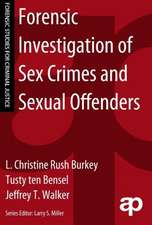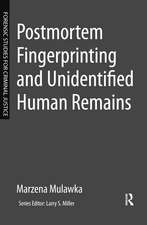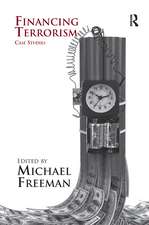Forensic Epidemiology: Principles and Practice
Editat de Michael Freeman, Maurice P. Zeegersen Limba Engleză Hardback – 9 mai 2016
- Historical perspective on how epidemiologic evidence of causation has been used in courts in the US and Europe
- Theory and science underlying the use of risk to assess individual causation
- Primer on epidemiologic methods, and various measures used to arrive at individualized comparative risk assessments and PC
- The use of statistical methods applied to publicly available data for ad hoc analysis of PC applicable to the specific circumstances of a case
- Background on complementary disciplines, including forensic pathology, death investigation, biomechanics, and survival analysis
- Examples of applied FE in the investigation of traffic injury and death, automotive and other product defect litigation, medical negligence, and criminal prosecution and defense
Preț: 607.33 lei
Preț vechi: 741.51 lei
-18% Nou
Puncte Express: 911
Preț estimativ în valută:
116.21€ • 121.33$ • 96.18£
116.21€ • 121.33$ • 96.18£
Carte tipărită la comandă
Livrare economică 28 martie-11 aprilie
Preluare comenzi: 021 569.72.76
Specificații
ISBN-13: 9780124045842
ISBN-10: 0124045847
Pagini: 434
Dimensiuni: 191 x 235 x 25 mm
Greutate: 1.06 kg
Editura: ELSEVIER SCIENCE
ISBN-10: 0124045847
Pagini: 434
Dimensiuni: 191 x 235 x 25 mm
Greutate: 1.06 kg
Editura: ELSEVIER SCIENCE
Public țintă
Primary: Forensic practitioners, public health, upper-level undergrad forensic epidemiology / forensic science instructors / studentsSecondary: Legal community
Cuprins
1. History of Epidemiology in the courts
2. History of FE
3. Basic tenets of Epidemiology
4. Different types of epidemiologic studies used in FE
5. Test accuracy
6. Statistical tests used in Epidemiology
7. Probability and the Law
8. Common logical fallacies encountered in FE
9. Causation
10. Sources of data for FE investigation
Adjunctive disciplines utilized in FE investigations
11. Medicine
12. Toxicology
13. Pharmacology
14. Biomechanics
15. Principles of death investigation
Applied Forensic Epidemiology
16. Governmental uses of epidemiologic investigation
17. FE in criminal cases
18. FE in civil cases
19. Toxic tort investigation
20. Product defect investigation
21. Injury litigation
22. Medical negligence
23. Life expectancy projections
2. History of FE
3. Basic tenets of Epidemiology
4. Different types of epidemiologic studies used in FE
5. Test accuracy
6. Statistical tests used in Epidemiology
7. Probability and the Law
8. Common logical fallacies encountered in FE
9. Causation
10. Sources of data for FE investigation
Adjunctive disciplines utilized in FE investigations
11. Medicine
12. Toxicology
13. Pharmacology
14. Biomechanics
15. Principles of death investigation
Applied Forensic Epidemiology
16. Governmental uses of epidemiologic investigation
17. FE in criminal cases
18. FE in civil cases
19. Toxic tort investigation
20. Product defect investigation
21. Injury litigation
22. Medical negligence
23. Life expectancy projections


















